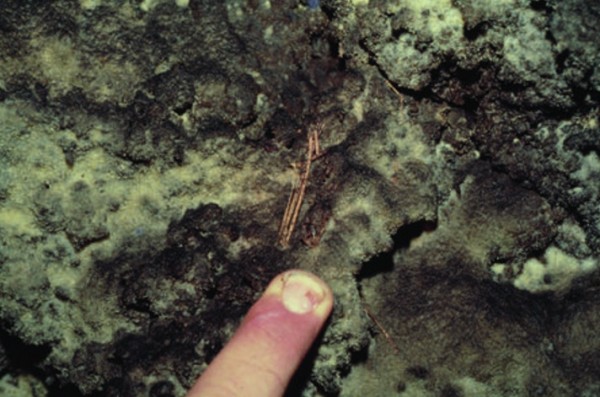By Ana Verayo, | March 24, 2016

Skeleton of Synemporion keana embedded in the wall of of Māhiehie Cave on Maui.
Scientists just revealed a new animal species that is native to the Hawaiian islands, as fossil evidence show another endemic species of bats that thrived in the archipelago, even before humans settled across the islands.
Like Us on Facebook
Previously, Hawaii was thought to be home to only two indigenous animal species, which are the Hawaiian hoary bat and the monk seal. In this new study, researchers detail this new bat species known as the Synemporion keana.
American Museum of Natural History researchers described the history of this bat, where the fossils are first discovered in a lava tube in Maui, which is a the second largest island in Hawaii by entomologist Francis Howarth in 1981. His team also uncovered similar skeleton remains in Oahu, Big Island, Kauai and Molokai.
Another scientist, Alan Ziegler, who is a mammologist, pointed out that the remains possessed different features that could be another bat species found in the same region. However, the search was stopped for a while when Ziegler passed away in 2003, where this research was resumed by the American Museum of Natural History's Nancy Simmons.
In this new study, Simmons says that it was a real surprise to discover another native species in the islands which is also another land mammal. This means that since Hawaii is in a very remote location in the Pacific, early animals that existed in the islands either swam or flew to land.
Other land animals like rats and dogs have been introduced to the islands when humans began colonizing the archipelago.
The new study also determined that the Synemporion keana is apparently smaller than the hoary bat where researchers also suggest that the two bats have been co-existing together for thousands of years. However, the hoary bat is the only native bat alive today where its existence is also threatened, being classified as an endangered species by the Endangered Species Conservation Act of 1969.
Scientists believe that the Synemporion keana became extinct due to direct and indirect effects of human colonization in Hawaii. The next step in this research is to work with the bats' ancient DNA retrieved from their fossils to identify its closest living relatives. This new study is published in the journal American Museum Novitates.
-
Use of Coronavirus Pandemic Drones Raises Privacy Concerns: Drones Spread Fear, Local Officials Say

-
Coronavirus Hampers The Delivery Of Lockheed Martin F-35 Stealth Fighters For 2020

-
Instagram Speeds Up Plans to Add Account Memorialization Feature Due to COVID-19 Deaths

-
NASA: Perseverance Plans to Bring 'Mars Rock' to Earth in 2031

-
600 Dead And 3,000 In The Hospital as Iranians Believed Drinking High-Concentrations of Alcohol Can Cure The Coronavirus

-
600 Dead And 3,000 In The Hospital as Iranians Believed Drinking High-Concentrations of Alcohol Can Cure The Coronavirus

-
COVID-19: Doctors, Nurses Use Virtual Reality to Learn New Skills in Treating Coronavirus Patients







